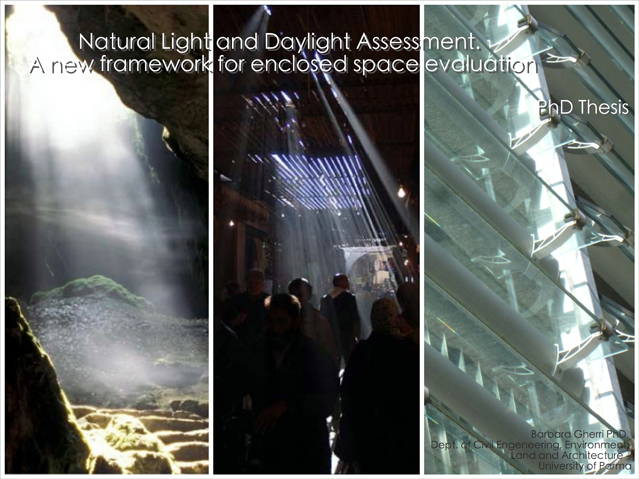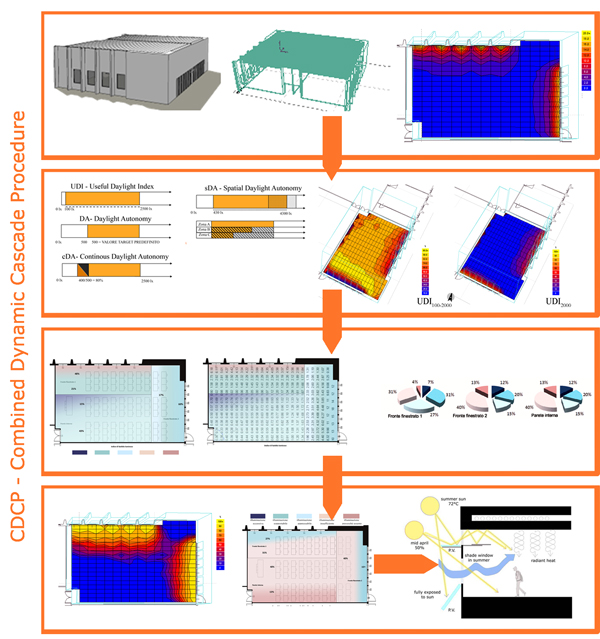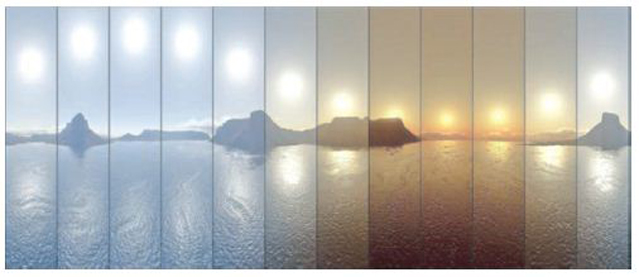
by Barbara Gherri, University of Parma, Department of Civil Engineering, Environment, Land and Architecture, Parma, Italy.
Natural Light and Daylight Assessment. A new framework for enclosed space evaluation (PhD Thesis)
The multiple ways by which natural light can be enhanced to define a room can be improved by the conscious use of daylight, involving several topics that concur in outlining the role of natural light as a matter of fact, space and representation. This thesis explores the spatial qualities of built environments through the use of natural light, involving energy savings strategies and visual comfort definition, although in current architectural practice, daylight is a deeply under-exploited natural resource. A proper natural lighting system, tailored to the requirements of architectural form and customized to occupants functional desires is an essential support to modern climate control policies, as well as to energy-saving measures and in reducing thermal loads.
The first section is thus about architectural practices, its related traditions, customs and rules that are closely linked to the use of natural light. The perceptive and constructive dimension of architectural lighting is here outlined, through a detailed excursus of daylight praxis among different occurrences and environments, based on chronological and geographical order, in order to critically explore some outstanding examples of architectural works, across historical treatises, through modern study cases, in which the issue of daylight integration in building envelope is fully achieved. The first part, focused on historical architectural experiences, gives way to a comprehensive review of daylighting techniques, proper solar devices and other technological solutions, to be adopted in order to enhance daylight penetration and to shade any undue dose of light.
In the second part this thesis explores the current daylight calculation method, that relies on daylight static performance although, due to daylight changeability, a precise daylight evaluation cannot be thoroughly assessed using single-moment simulations, or single point in time method, as DF does. The most common daylight design methods and tools, based on DF or other geometrical appraisals are currently the sole quantitative performance metrics to implement daylighting in buildings, but they are quite inadequate, since each simulation represents only one time of year and time of day under a theoretical overcast sky condition.
Conversely, a Climate Based methodology and DDS performance metrics should help in carrying out high-quality lighting predictions along with building energy simulations. A new schema to assess daylighting potential, considering a multiphase approach is here introduced. In this context, a “Combined Dynamic Cascade Procedure- CDCP” framework is here defined to address all the DF impairments and to provide a holistic scheme to merge quantitative data –thanks to the CBDM metrics–with qualitative evaluation facts – inferred from POE investigation, carried out among building occupants. Thanks to the CDCP, any retrofit actions can be exactly estimated, in order to maximize the benefits of refurbishment actions and to promote effective environmental retrofit strategies, according to the actual users’ needs.
For the first time, the capability of the new CDCP merges the potentials implicit into CBDM on a larger scale, by focusing on multiple layers, according with a top down appraisal and thanks to software simulations. A complete case study is then examined to prove the benefits of such a procedure.
The entire dissertation can be downloaded at http://dspace-unipr.cilea.it/handle/1889/1880?mode=full
and a book can be ordered in Italian at http://www.francoangeli.it/ricerca/Scheda_libro.aspx?ID=21433&Tipo=31
Daylight Assessment. Il ruolo della luce naturale nella definizione dello spazio architettonico e protocolli di calcolo
by Barbara Gherri
Negli ultimi decenni, una rinnovata attenzione verso i benefici derivanti da un uso appropriato della luce naturale ha focalizzato l’attenzione sulla necessità di definire un nuovo paradigma, in grado di valutare correttamente la variabilità della quantità luminosa tale da essere impiegato, non solo per valorizzare la presenza di luce naturale come strumento di definizione espressiva dello spazio costruito, ma anche per ridurre la richiesta di energia elettrica e termica negli edifici.
Il testo analizza i vantaggi connessi all’impiego della luce naturale, mettendo a confronto esperienze architettoniche, formali, espressive e tecnologiche che riconoscono nella luce naturale l’elemento connotante dello spazio costruito.
Attraverso un excursus storico, dalla trattatistica fino alle sperimentazioni del moderno, si giunge a una rassegna analitica di sistemi tecnologici e strumenti per l’illuminazione naturale, secondo la tradizionale dicotomia “penetrazione-schermatura”, comprendendo inoltre questioni ambientali ed energetiche.
Un’approfondita indagine sui differenti metodi di valutazione della luce naturale ne evidenzia carenze e inesattezze, mostrando dunque la necessità di definire una nuova procedura di calcolo, che sia in grado di mettere a sistema valutazioni puramente qualitative con i parametri dinamici di nuova definizione, per mettere a disposizione del progettista e del tecnico uno strumento multicriterio da applicare sia nella fase di progettazione ex novo, sia negli interventi di retrofit.
Alla procedura così definita sono affiancati gli esiti di una simulazione su un caso di studio, al fine di fornire una dimostrazione esaustiva dei vantaggi che l’analisi dinamica integrata può assicurare nella fase di progettazione, uso e gestione di uno spazio confinato.
To order the book, go http://www.francoangeli.it/ricerca/Scheda_libro.aspx?ID=21433&Tipo=31
Barbara Gherri, architetto, PhD in Forme e Strutture dell’Architettura, assegnista di ricerca in Architettura Tecnica presso il Dipartimento di Ingegneria Civile, dell’Ambiente, del Territorio e Architettura presso l’Università di Parma. Svolge attività di ricerca sul tema della gestione e del calcolo della luce naturale per gli spazi confinati. Ha partecipato a conferenze internazionali sul tema del daylighting, con pubblicazioni scientifiche su riviste e libri di settore. Si occupa anche di progettazione bioclimatica, valutazioni energetiche e ambientali sul costruito, partecipando a gruppi di ricerca nazionali (PRIN 08) e internazionali (Low Carbon innovations), nel quadro del Climate-KIC.





